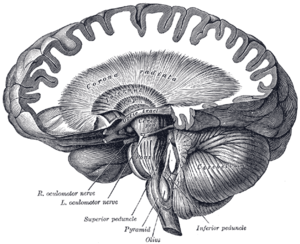Neuroferritinopathy
| Neuroferritinopathy | |
|---|---|
 |
|
| Classification and external resources | |
| ICD-10 | G23.0 |
| OMIM | 606159 |
| MeSH | C548080 |
| Orphanet | 157846 |
Neuroferritinopathy or adult-onset basal ganglia disease is a genetic neurodegenerative disorder characterized by the accumulation of iron in the basal ganglia, cerebellum, and motor cortex of the human brain. Symptoms, which are extrapyramidal in nature, progress slowly and generally do not become apparent until adulthood. These symptoms include chorea, dystonia, and cognitive deficits which worsen with age.
This disorder is autosomal dominant and is caused by mutations in the gene encoding the light chain subunit of the ferritin protein. Wild type ferritin functions as a buffer for iron, sequestering it and controlling its release. Thus, mutations in the light chain of ferritin result in the accumulation of iron in the brain which can be imaged using MRI. Currently, neuroferritinopathy is the only neurodegenerative disease with an iron accumulation in the brain classified as an autosomal dominant syndrome.
Treatment of neuroferritinopathy is focused on managing symptoms associated with chorea and dystonia using standard medications for each. The disorder is progressive and symptoms become worse with age. Fewer than 100 cases of neuroferritinopathy have been reported since its identification in 2001. Its incidence has been largely localized to Northeast England suggesting a founder effect. Due to its genetic nature, current research is focused on therapeutic management of the symptoms caused by the disorder.
All brain iron disorders were previously labeled Hallervorden-Spatz syndrome, after the scientists who first discovered individuals with abnormal iron levels in 1922. Brain iron disorders are now divided into three categories: genetic neurodegeneration with brain iron accumulation, genetic systemic iron accumulation with neurologic features, and acquired diseases associated with iron excess or iron deficiency. Neuroferritinopathy is classified under the first category, genetic neurodegeneration with brain iron accumulation. Neuroferritinopathy is classified as a late-onset basal ganglia disease and is a dominantly inherited neurodegenerative disease. Four different alleles are responsible for neuroferritinopathy. Three arise from nucleotide insertions in the ferritin light chain (FTL) polypeptide gene while the fourth arises from a missense mutation in the FTL gene.
...
Wikipedia
